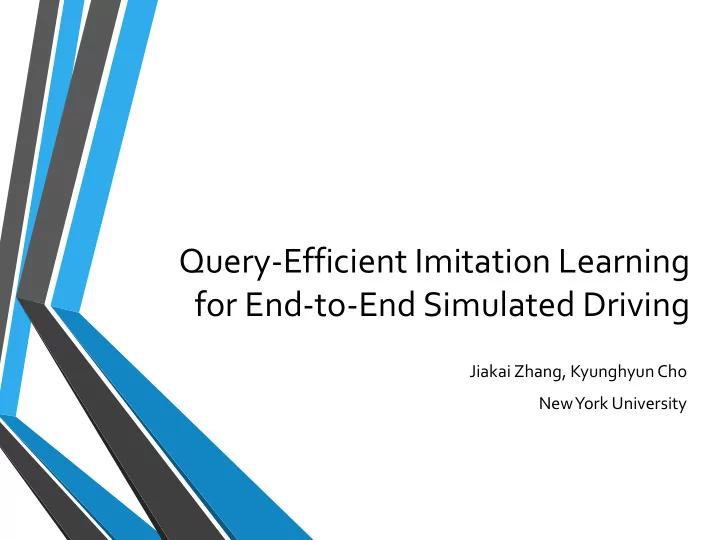

Query-Efficient Imitation Learning for End-to-End Simulated Driving Jiakai Zhang, Kyunghyun Cho New York University
Overview Introduction • End-to-end learning for self-driving • Related work Learning method • Convolutional neural network • Imitation learning using SafeDAgger Experiment • Setup • Results Conclusion and future work
Introduction End-to-end learning for self-driving • Sensory input from front-facing camera • Control signal Steering Brake
Introduction Related work • Supervised learning • ALVINN net [Pomerleau 1989] • DeepDriving [Chen et al. 2015] • End-to-end learning for self-driving cars [Bojarski et al. 2016] • Imitation learning • DAgger [Ross, Gordon, and Bagnell 2010] • SafeDAgger [Zhang and Cho 2017]
DAgger algorithm Dataset 𝐸 0 Policy 𝜌 1 Initialize Policy 𝜌 𝑗 = 𝛾 𝑗 𝜌 ∗ + (1 − 𝛾 𝑗 ) Dataset 𝐸 ′ 𝜌 𝑗 Iteration Dataset 𝐸 𝑗 = 𝐸 ′ ∪ 𝐸 𝑗−1 Policy 𝜌 𝑗 Disadvantage: Return Best policy 𝜌 𝑗 • Query a reference policy constantly • Safe issue to environment
SafeDAgger algorithm Policy 𝜌 1 Safety classifier 𝑑 1 Initialize Dataset 𝐸 0 Policy 𝜌 𝑗 = 𝛾 𝑗 𝜌 ∗ + (1 − 𝛾 𝑗 ) 𝜌 𝑗 Dataset 𝐸 ′ not safe Safety classifier 𝑑 𝑗 Iteration Policy 𝜌 𝑗 Dataset 𝐸 𝑗 = 𝐸 ′ ∪ 𝐸 𝑗−1 Safety classifier 𝑑 1 Advantage: Return Safety classifier 𝑑 𝑗 Best policy 𝜌 𝑗 • Query-efficient • Safety feature
Safety classifier • Deviation of a primary policy from a reference policy defined • Optimal safety classifier defined as Learning safety classifier • Minimize a binary cross-entropy loss
Experiment – Setup TORCS – Open source racing game Training tracks Test tracks
Experiment – Model Input image – 3x160x72 Convolutional layer – 64x3x3 x 4 Max Pooling – 2x2 Convolutional layer – 128x5x5 Feature map x 2 Fully connected layer x 2 Fully connected layer Control Environment Safety value signals variables Primary policy Safety classifier Optimization algorithm: stochastic gradient descent
Results Safe Frames Unsafe Frames
Results Evaluation on test tracks 1. Mean squared error of steering angle 2. Damage per lap 3. Number of laps 4. Portion of time driven by a reference policy
Results Mean squared error of steering angle MSE (Steering Angle) # of Dagger Iterations Dashed curve – with traffic Solid curve – without traffic
Results Damage per Lap Damage per Lap # of Dagger Iterations Dashed curve – with traffic Solid curve – without traffic
Results Number of Laps Avg. # of Laps # of Dagger Iterations Dashed curve – with traffic Solid curve – without traffic
Results Portion of time driven by a reference policy % of c safe = 0 # of Dagger Iterations Dashed curve – with traffic Solid curve – without traffic
Demo
Conclusion Proposed SafeDAgger algorithm • Query efficient • Safety feature End-to-end simulated driving • Trained a convolutional neural network to drive in TORCS with traffic Future work Evaluate SafeDAgger in the real world Learn to use temporal information
Recommend
More recommend